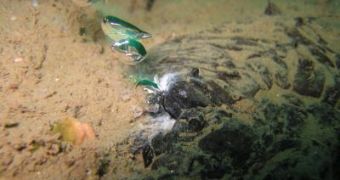Methane gas escapes from ocean floor fossil deposits at a rate of about two hundred or more cubic meters every day, which poses some environmental concerns, as the methane gas is a greenhouse gas, which causes a global warming effect 23 times more accentuated than carbon dioxide would, during a century. About half of that quantity is being dissolved into the ocean water, however, the other half of the quantity is thought to escape into the Earth's atmosphere.
Recent studies have shown that we have nothing to fear so far, as only about one percent of the whole methane volume, emitted by the ocean floor, escapes into the atmosphere. So, what happens to the other 49 percent of gas that all studies show should reach the ocean surface? It appears that even in shallow waters, the ocean is capable of absorbing most of the quantity bubbling up from the floor.
The biggest emitter of such gases, Coal Oil Point, or COP, is located near the coast of the United States, in the Santa Barbara Channel area. Studies related to the fate of these emissions, made by researchers from the University of California, predict that the undissolved quantity of methane gas escaping from the ocean floor is being oxidized by the microbial activity in the ocean.
During the data gathering stage of the study, involving a surface area of about 280 square kilometers, Susan Mau revealed the presence of more than 79 gas plumes to reach the ocean surface, over an area of 70 square kilometers. Furthermore, monthly sample gathering shows that the gas concentration on the surface of the ocean is greatly affected by currents' circulation, and increased wind activity further increases the quantity of gas emitted by the ocean. Scientists believe that most of the natural gas quantity does not escape to the surface, but is being picked up by deep oceanic currents and transported below the surface of the water.
During this process, the gas is being broken down by microbial activity feeding on the gas. To make better resolution observations on the water samples, Mau used a mass spectrometer tied behind the boat, which seems to back up her discovery. Though the COP area emits the biggest annual quantity of methane gas by seeping from the ocean floor, these underwater fossil fuel deposits that emit high quantities of natural gas can be found in most of the oceanic areas.

 14 DAY TRIAL //
14 DAY TRIAL //